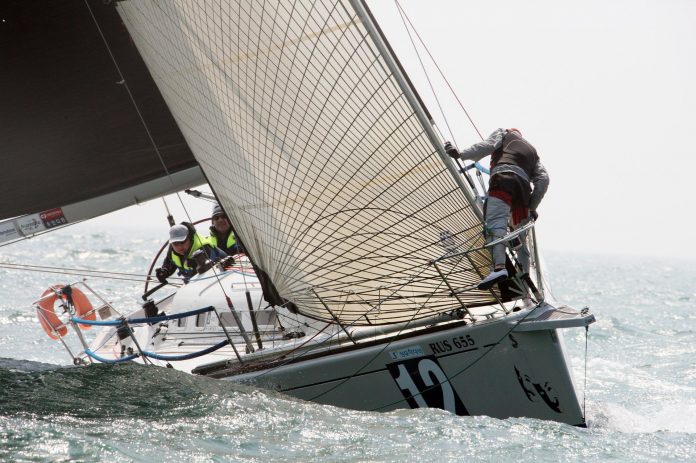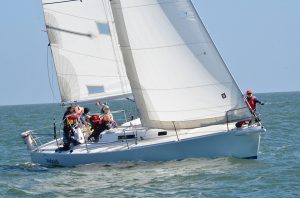

Your upwind Sweet Spot is the point of sail in which you sail against the wind most efficiently and at a consistent angle of heel. Also known as the “groove”, it covers a range of a few degrees angle to the wind in which you are able to steer consistently at a steady speed.
The sweet spot for your boat may be narrow, with a tolerance of only a couple degrees, or wide, in which you can head up or down several degrees. If it is wide, you can handle gusty winds and steer around waves better, but you won’t point as close to the wind.
If it’s narrow, you must maintain a precise course, which can be a challenge in variable winds but can be very fast in flat water.
The groove for a given condition, is when forward speed and pointing are as good or better than boats around us.
Visual cues –
If your telltales react too fast on both sides of the sail, the entry angle is super narrow; if the sail actually luffs before the telltales react, the entry angle is too wide.
Headstay Sag is Fast Upwind in light Air –
When the headstay sags, it not only sags to leeward but also sags aft, which puts the luff closer to the leech, thereby adding depth to the jib.
The key controls for manipulating headstay sag are shroud tension, mainsheet tension, and in some cases, headstay length.
In light air, the number one adjustment for headstay sag on boats with either deck-stepped or keel-stepped masts is varying the shroud tension. More tension effectively pulls the mast aft—assuming the chainplates are aft of the mast. If the lower shrouds are farther aft, they will have the most effect on boats with aft-swept spreaders.
When you sag the headstay, the maximum draft in your jib moves forward. To compensate and keep the draft aft, ease halyard tension, which also creates additional power.
When headstay sag is increased, the headsail becomes deeper and more powerful. If your boat is underpowered, this can make a big difference, especially in choppy wave conditions.
Upwind in Breeze –
When the breeze is up, speed first, then pointing. You also have to deal with the waves that usually accompany big breezes, they take extra speed to get through.
Make sure both sails are as flat as you can make them using backstay, outhaul, luff tension, etc. The real key is not to trim as hard as you would in normal wind conditions.
Start with the sails eased so it is easy to get the boat going and then gradually wind them in. When the boat gets hard to steer and hard to keep moving, you’ve gone too far.
Both sails need to be de-powered evenly. A common mistake is to have the jib sheeted in hard with the mainsail trying to do all the work.
If the mainsail is luffing completely in the puffs to keep the boat on its feet, you need to change the jib setup. Move the lead aft (or up and out if you have athwartship jib tracks) to flatten the foot and twist off the top of the sail.
A constant angle of heel is the goal, don’t worry so much about the telltales. Too much heel and you will have too much weather helm. Too flat and you will not generate enough speed.


